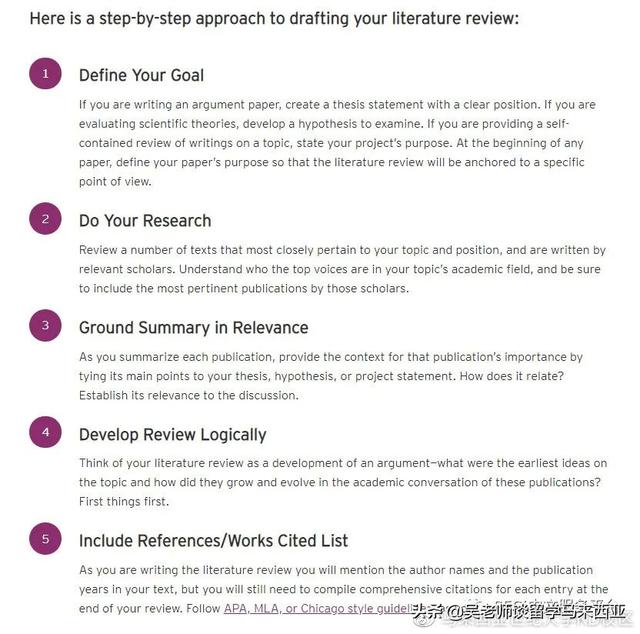来马来西亚留学的同学,都会非常关心如何写好毕业论文,这样才能早点毕业。今天给大家介绍下马来西亚学位论文的写作框架及相关要求,希望对大家有所帮助。
马来西亚正常学位论文一般包括5章,如果你的研究能力非常强当然也是可以写到chapter6,chapter7......都是没有问题的。
第一章 介绍
(introduction)
1.1 Focus of the Study
1.2 Context of the Study
1.2.1 Reasons for the Decline in Malaysian English Language Performance
1.2.2 The Teaching English Language in Malaysia
1.2.3 The Teaching of Writing in Malaysian ESL classrooms
1.2.4 The Teaching of ESL Writing Skills at Universiti MalaysiaSabah
1.3 ProblemStatement.
1.4 ResearchObjectives
1.5 ResearchQuestions
1.6 Scope of the Study
1.7 Significance of the Study
1.8 Delimitation of the Study
1.9 Definitions of Terms
1.10 Thesis Organization
1.11 Summary of Chapter One
我们可以看出在第一章中主要需要说明清楚几个问题!
研究的状况,问题的背景,问题的阐述,研究的目标,研究的问题,研究的范围,研究的意义,研究的限制,关键术语的定义。
第二章 文献综述
(literature review)
2.1Introduction
2.2 ESL Writing Instruction andCulture
2.3 Approaches to the Teaching ofWriting
2.3.1 The Product Approach
2.3.1.1 Critics of the ProductApproach
2.3.2 The Process Approach
2.3.2.1 Activities in a ProcessWriting Class
2.3.2.2 Composition Studieswithin the Process Approach
2.3.2.3 Stages of WritingPrescribed by the Process Writing Approach
2.3.2.4 Critics of the ProcessApproach
2.3.3 The Post-Process Approach
2.3.3.1 Critics of thePost-Process Approach
2.4 Research on the SecondLanguage Writing Process
2.4.1 Second Language Studies onProcess Approach
2.4.2 Research on AcademicWriting
2.4.3 Studies on Peer Feedback
2.5 A Case for a Mixed Approachto the Teaching of Writing in a Malaysian Context
2.5.1 Theory ofScaffolding
2.5.2 Language Support
2.5.3 Five-Paragraph EssayStructure
2.6 ThisResearch
2.7 Research Framework
2.8 Chapter Summary
每个人的论文内容不同,所以文献综述会写的有差别。


APA是马来西亚用的参考文献格式。
第三章 研究方法
(research methodology)

3.1Introduction
3.2 ResearchDesign
3.2.1 Mixed Method
3.2.2 Designs of Mixed-Method Research
3.3 Sample of the Study
3.4 Research Procedures and Instruments
3.4.1 Data Collection: Research Procedure and Instruments
3.4.2 Type of Mixed MethodsDesign Used in this Study- Sequential Explanatory Design
3.4.3 ResearchFramework
3.5 Validity and Reliability
3.5.1 QuantitativeData
3.5.2 Qualitative Research
3.6 PilotStudy
3.7 Research Procedures
3.7.1 Questionnaire
3.7.1.1 Validity and Reliablity of the Questionnaire
3.7.1.2 Questionnaire Arrangement
3.7.1.2 Response Scale
3.7.2 Pre-test and Post-TestEssay Writing
3.7.3 Written Essays
3.7.3.1 Marks Improvement betweenEssays: Pre-, Post and Delayed Post-Interventon Essays
3.7.3.2 Tests of within SujectsEffects
3.7.3.3 Essay Text Analysis
3.7.4 Final WrittenTest
3.8 Data Analysis Procedures
3.8.1 Questionnaire Responses
3.8.2 Pre-test and Post-testEssay Writing
3.8.3 Written Essays
3.8.4 Written Final ExamMarks
3.9 Statistical Analysis
3.9.1 Descriptive Statistics
3.9.2 T-Test
3.9.3 Correlations.
3.9.4 Structural Equation Modelling.
3.10 Softwares used for DataAnalysis
3.10.1 SPSS for Analyzing Pre-and Post-tests Results and Observations
3.10.2 AMOS for Analyzing Questionnaires
3.11 TheIntervention
3.12 Comparison of In-situ andIntervention Teaching Methods
3.13 Summary of ChapterThree
研究的方法有很多,混合型,定量研究,定性研究,这需要根据你的论文需要选择合适的研究方法。最简单的就好比问卷调查法(Questionnaire)。
In your thesis or dissertation, you willhave to discuss the methods you used to do your research. The methodology ormethods section explains what you did and how you did it, allowing readers to evaluate the reliability and validity of the research. It should include:
1.The type of research you did
2.How you collected your data
3.How you analyzed your data
4.Any tools or materials you used in theresearch
5.Your rationale for choosing these methods
第四章 数据分析结果讨论
(data analysis discussion)
4.1 Introduction
4.2 Analysis of Questionnaire Data
4.2.1 Exploratory Factor Analysis
4.2.1.1 Writing Behaviour
4.2.1.2 Writing Attitude
4.2.1.3 Writing Difficulties
4.2.2 Discussion of Section4.2.1
4.2.3 Confirmatory FactorAnalysis.
4.2.3.1 Confirmatory FactorAnalysis for Writing Attitude Factor
4.2.3.2 Confirmatory FactorAnalysis for Writing Behaviour Factor
4.2.3.3 Confirmatory FactorAnalysis for Writing Difficulties Factor
4.2.4 Discussion of Section4.2.3.
4.2.5 Analysis of Structural Model
4.2.5.1 Discussion on the Relationships between Students’ English Writing Performance and MUET Results
4.2.5.2 Discussion on the Differences across Groups for Students’ English Writing Performance and MUETResults
4.2.5.3 Discussion on the Differences across Groups for Students’ English Writing Performance based onKnowledge on Different Aspects of Academic Writing (KAAW)
4.2.6 Analysis of Questionnaire Data Conclusion
4.3 Quantitative Intervention Data
4.3.1 Analysis of Experimentaland Control Groups Pre- and Post-Test Result
4.3.2 Analysis of Paired-SamplesT-Test of Pre-, Post- and Delayed Post-Intervention Essay Results
4.3.3 Analysis of Students’Revision Types Data
4.3.3.1 Frequency of the Types ofEditing Activities Performed by the Students
4.3.3.2 Results for Surface Changes
4.3.3.3 Results for Meaning Surface Changes
4.3.3.4 Correlations of Surfaceand Meaning Changes Made by the Students When Reviewing theirEssays
4.3.4 Discussion of Quantitative Intervention Data
4.4 Qualitative InterventionData
4.4.1 Findings of Analysis on Students’ Essays x
4.4.1.1 Discussion of Good Studnets’ Essay Analysis
4.4.1.2 Discussion of Medium of Studnets’ Essay Analysis
4.4.1.3 Discussion of Poor Studnets’ Essay Analysis
4.4.2 Findings of Pre-, Post- and Delayed Post-Intervention Essays
4.4.3 Analysis of Students’Diaries
4.4.3.1 Students’ Opinions of the Intervention Class
4.4.3.2 Students’ Opinions of Working on Groups
4.4.3.3 Students’ Opinions of Intervention Class Activities
4.4.3.4 Discussion of the Students’ Diary Data
4.4.4 Qualitative Intervention Data Conclusion
可以参考上面提供的模板来写自己的数据分析和结果讨论。
第五章 结论和建议
conclusion and recommendation

5.1 Introduction
5.2 Summary of the Study
5.3 Research QuestionOne
5.4 Research QuestionTwo
5.5 Research Question Three
5.6 Contribution to the Field of SecondLanguage Teachingand Learning in Malaysia
5.7 Limitations of the PresentStudy
5.8 Pedagogical Implications
5.9 Directions for Future Research
5.10 Conclusion
这是论文的最后一章,目的就是总结和给出一些相关的建议。

更多关于马来西亚世纪大学,马来西亚留学信息,欢迎咨询世纪大学国际部TOMMY团队(myedu0060)
,




